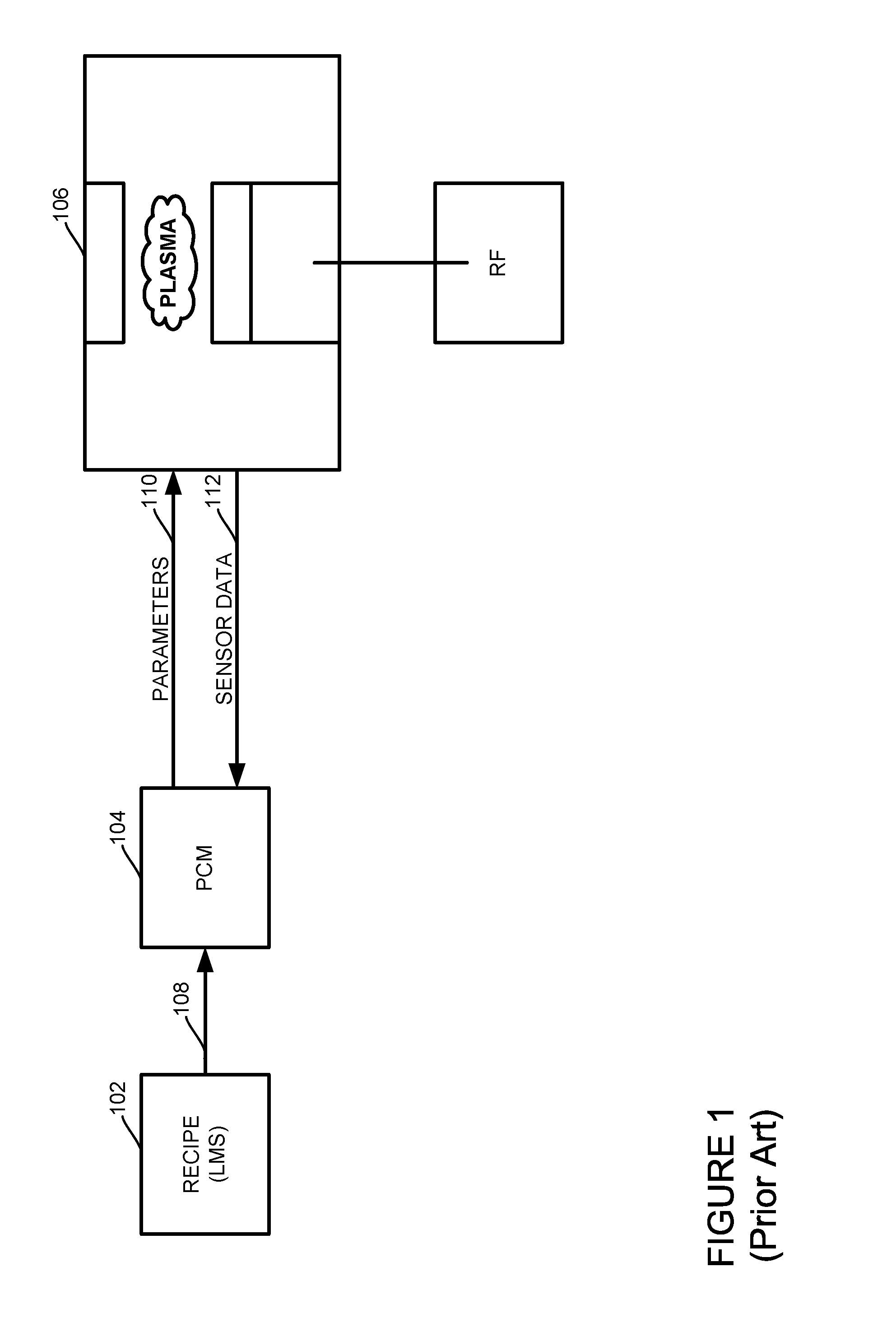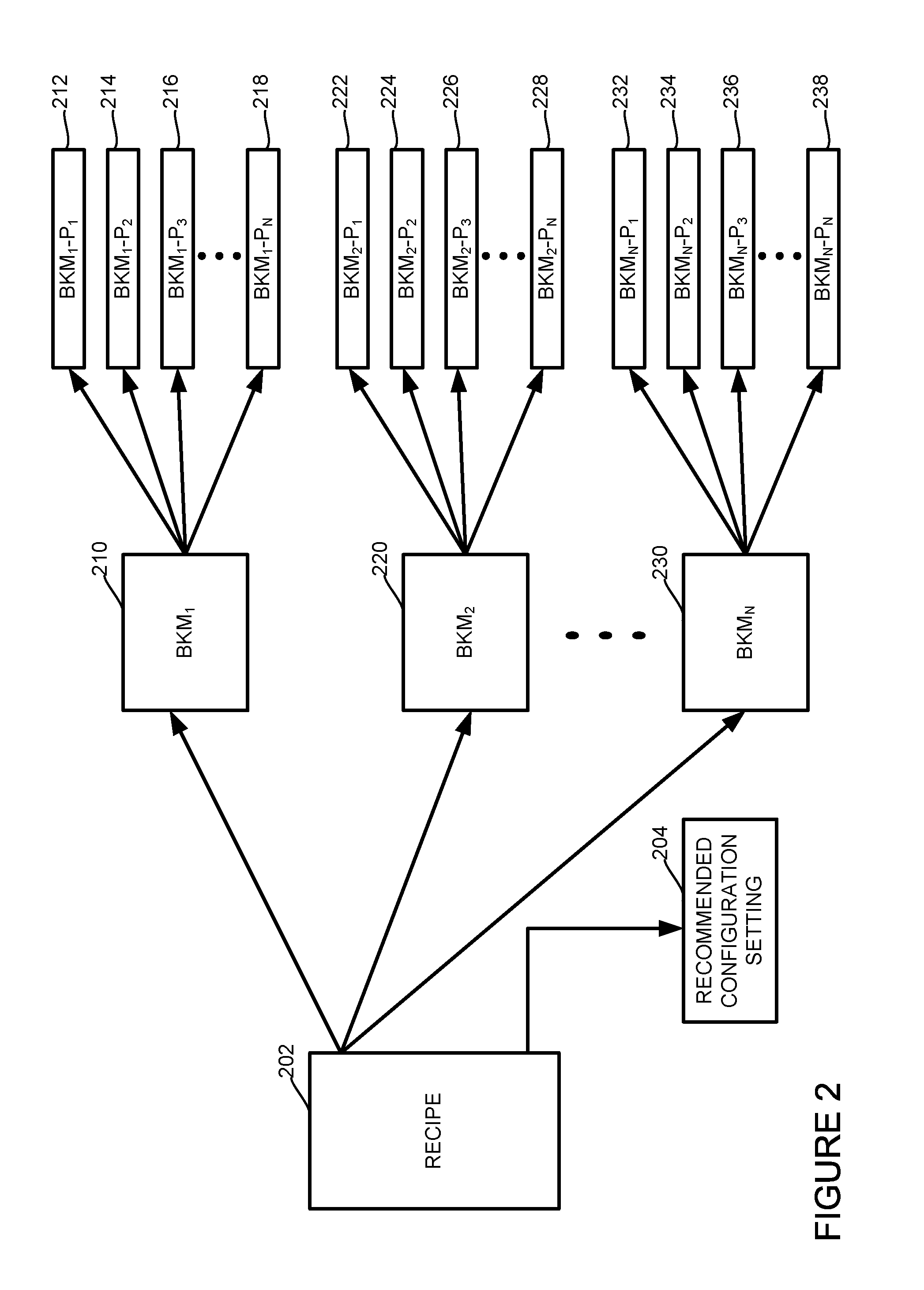[0027]The features and advantages of embodiments of the invention may be better understood with reference to the figures and discussions that follow. FIG. 2 shows, in an embodiment, a simple diagram of a recipe associated with a plurality of BKM modules. A multi-steps monolithic recipe 202 may be modularized into a plurality of functional blocks, which may be associated with a plurality of BKM modules (210, 220, and 230). Each BKM module may have a plurality of parameters (212-218, 222-228, and 232-238). In an embodiment, each parameter may be controlled by rules which may define the permissible values that may be entered for each
cell. In addition, each
cell may have default value suggestion. Further each BKM module may have recommended configuration settings for the processing system hardware.
[0028]As mentioned above, each BKM module may include best practice specifications. In addition, each BKM module may relate to a process stage and may include at least one recipe step. In creating a recipe, a user may utilize a BKM driven recipe editor to call forth a plurality of BKM modules. FIGS. 3, 4, and 5 illustrate examples of interfaces for a BKM driven recipe editor.
[0029]FIG. 3 shows, in an embodiment, an example of a main view of a BKM driven recipe editor interface. In the main view, an interface 302 shows a recipe with 3 BKM modules (304, 306, and 308). In an embodiment, the manufacturer of the processing system hardware may determine the number of BKM modules and the sequence of the BKM modules for each recipe. Accordingly, parameter value entry is assured to be conforming to the manufacturer's BKM if the BKM is followed. By clicking on a BKM module, such as BKM module 304, and clicking an “open” button 350, a user may call forth the parameters for BKM module 304.
[0030]FIG. 4 shows, in an embodiment, an example of a value view of a BKM driven recipe editor interface. In the value view, a user may enter values for each of the parameters within the guidelines of the BKM rules. An interface 402 shows a value view of BKM module 304 of FIG. 3. BKM module 304 may have a plurality of columns, including a parameter description column 404, a
setpoint column 408, a soft tolerance column 410, and a hard tolerance column 412. The value of each
cell may be changed within the guidelines of the rules (applicable to the cells and not shown in FIG. 4). Each of the cells for columns 408, 410 and 412 may include rules, which limit the permissible values that may be entered for each cell. (Refer to Table 1 below for examples of the rules). In an example, for a parameter cell 420 (Head Pair 1 Top DIW Flow), the default value for a
setpoint cell 422 is set to “off”. When the user click on
setpoint cell 422, the user may change the value of the cell. However, the values that may be accepted for each cell may be limited by the rules that may be set for each parameter.
TABLE 1Examples of RulesRuleDescriptionDefaultuse the default value coded in the softwareExactuse the value specified in the BKMUserBKMallow the user to specify the value when creating a BKMUserRecipeallow the user to specify the value when using a BKM in arecipePrevioususe the value from the previous stepCustomcustom logic for setting the value is coded in the BKM
[0032]In an embodiment, the BKM driven recipe editor may have the ability to take BKMs (i.e., new best practices) that may be propagated by the production engineers or experts associated with the tool manufacturer and translate the BKMs into rules that may be applied to the cells of the affected parameters of the BKM modules. Thus, recipes may be created and / or modified with updated BKMs without requiring the user to be knowledgeable about the changes.
[0033]In an embodiment, the BKM-driven modification of existing recipes may be remotely triggered by the tool manufacturer and the
resultant changes to the parameters are communicated to the tool user for approval and / or as a courtesy notification. In an embodiment, when BKMs are changed, the new BKM may be sent via a
computer network (e.g.,
the internet) to the tool users (or to the tool directly) to be applied against existing recipes. An updated BKM may specify new parameters that may need to be included with an existing recipe or different
permissible value ranges for existing parameters. This “BKM audit” may provide information to the tool user (or tool manufacturer, if access is allowed by the tool users) regarding whether one or more of the parameter values associated with an existing recipe may need to be modified in view of the changed BKM. In this manner, knowledge gained by the experts in one
plant or by the tool manufacturer's experts may advantageously propagated in a manner that can be benefited by all tool users without threatening the
confidentiality of the recipe of any particular tool users.
[0034]In another embodiment, BKM driven recipe editor may be utilized to accommodate the “proprietary recipe” of substrate manufacturers. Proprietary recipes may be closely guarded by their owners since they may give distinct
advantage over competitors. By using the BKM driven recipe editor, experts may create new BKM modules and / or may manipulate current BKM modules to accommodate the proprietary recipes.
[0035]FIG. 6 shows, in an embodiment, a
flow chart illustrating an example of how the BKM may be employed to create BKM driven recipe. At a first step 602, an expert associated with a tool owner may activate a BKM driven recipe editor. In an embodiment, the BKM driven recipe editor may include BKMs, which may include best practice specifications for recipes. For each recipe, the BKMs may be encapsulated within a plurality of BKM modules.
[0036]At a next step 604, if the BKM modules include BKMs that are sufficient for the creation of a recipe then the BKM modules may not have to be changed and an operator may create new recipe by employing the BKM driven recipe editor to enter values for the parameters within the guidelines of BKM rules, at a next step 614. In an example, the rules for the parameters of the BKM modules include best practice specifications. The BKM modules may be sufficient if an operator is able to create new BKM driven recipe without changing the rules of the parameters of one or more BKM modules. However, if the BKM modules are not sufficient at a next step 604, then the BKM modules may have to be modified or new BKM modules may have to be created. In an example, if the expert wants to implement proprietary recipes, the BKM modules with best practice specifications may not be sufficient and may require changes in the rules of the parameters of one or more BKM modules.
 Login to View More
Login to View More  Login to View More
Login to View More 


